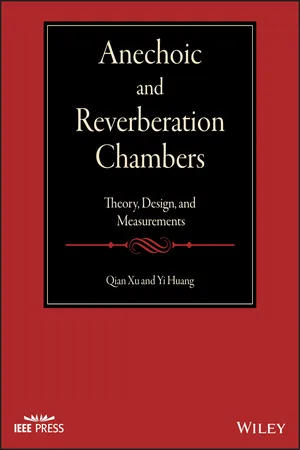
- English
- ePUB (mobile friendly)
- Available on iOS & Android
About this book
A comprehensive review of the recent advances in anechoic chamberand reverberation chamber designs and measurements
Anechoic and Reverberation Chambers is a guide to the latest systematic solutions for designing anechoic chambers that rely on state-of-the-art computational electromagnetic algorithms. This essential resource contains a theoretical and practical understanding forelectromagnetic compatibility and antenna testing. The solutions outlined optimise chamber performance in the structure, absorber layout and antenna positions whilst minimising the overall cost. The anechoic chamber designs are verified by measurement results from Microwave Vision Group that validate the accuracy of the solution.
Anechoic and Reverberation Chambers fills this gap in the literature by providing a comprehensive reference to electromagnetic measurements, applications and over-the-air tests inside chambers. The expert contributors offer a summary of the latest developments in anechoic and reverberation chambers to help scientists and engineers apply the most recent technologies in the field. In addition, the book contains a comparison between reverberation and anechoic chambers and identifies their strengths and weaknesses.This important resource:
• Provides a systematic solution for anechoic chamber design by using state-of-the-art computational electromagnetic algorithms
• Examines both types of chamber in use: comparing and contrasting the advantages and disadvantages of each
• Reviews typical over-the-air measurements and new applications in reverberation chambers
• Offers a timely and complete reference written by authors working at the cutting edge of the technology
• Contains helpful illustrations, photographs, practical examples and comparison between measurements and simulations
Written for both academics and industrial engineers and designers, Anechoic and Reverberation Chambers explores the most recent advances in anechoic chamberand reverberation chamber designs and measurements.
Frequently asked questions
- Essential is ideal for learners and professionals who enjoy exploring a wide range of subjects. Access the Essential Library with 800,000+ trusted titles and best-sellers across business, personal growth, and the humanities. Includes unlimited reading time and Standard Read Aloud voice.
- Complete: Perfect for advanced learners and researchers needing full, unrestricted access. Unlock 1.4M+ books across hundreds of subjects, including academic and specialized titles. The Complete Plan also includes advanced features like Premium Read Aloud and Research Assistant.
Please note we cannot support devices running on iOS 13 and Android 7 or earlier. Learn more about using the app.
Information
1
Introduction
1.1 Background
1.1.1 Anechoic Chambers

Table of contents
- Cover
- Table of Contents
- About the Authors
- 1 Introduction
- 2 Theory for Anechoic Chamber Design
- 3 Computer‐aided Anechoic Chamber Design
- 4 Anechoic Chamber Design Examples and Verifications
- 5 Fundamentals of the Reverberation Chamber
- 6 The Design of a Reverberation Chamber
- 7 Applications in the Reverberation Chamber
- 8 Measurement Uncertainty in the Reverberation Chamber
- 9 Inter‐Comparison Between Antenna Radiation Efficiency Measurements Performed in an Anechoic Chamber and in a Reverberation Chamber
- 10 Discussion on Future Applications
- Appendix A: Code Snippets
- Appendix B: Reference NSA Values
- Appendix C: Test Report Template
- Appendix D: Typical Bandpass Filters
- Appendix E: Compact Reverberation Chamber at NUAA
- Appendix F: Relevant Statistics
- Index
- End User License Agreement